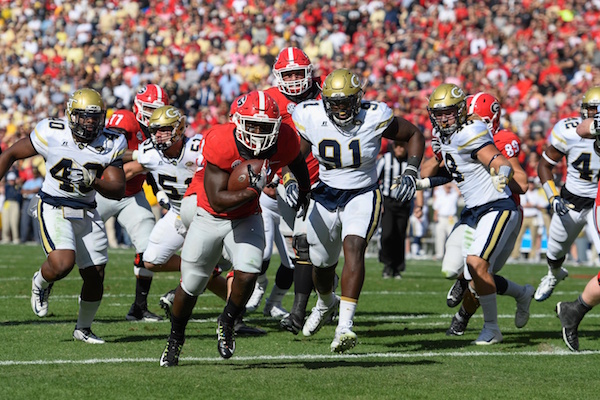
SEC teams with best second (or third) options at RB
Given early NFL departures and injuries to key players, having multiple options at running back is a necessity in the SEC.
Here’s our look at which teams have the best back-up options heading into next season.
1. GEORGIA
No team got a bigger lift from players — especially running backs — returning from would-be departures to the NFL than Georgia. Nick Chubb last season rushed for 1,130 yards and eight touchdowns in 13 games, while Sony Michel had 840 yards and four touchdowns in 12 games. Chubb had five 100-yard games and Michel is more dangerous in the passing game. But Kirby Smart is cautious about having them on the field at the same time. Throw in last season’s surprise contributor Brian Herrien, much-hyped prospect Elijah Holyfield and newcomer D’Andre Swift, who are all capable of flashes up the depth chart.
2. ALABAMA
There’s no argument on the depth in the Alabama backfield, what with Damien Harris, Bo Scarbrough, newcomer Najee Harris, B.J. Emmons, Brian Robinson and Josh Jacobs. The crowded backfield is one of the most talked-about storylines across the country this spring. The combination of new offensive coordinator Brian Daboll and the stable of four former 5-star recruits in the backfield with the addition of No. 1 recruit Harris. With all the recent talk under Lane Kiffin of stretching the field in the passing game, this group should get a heavy dose of carries that shape the offense. The only tougher task than choosing the No. 1 option of this group is choosing the second and third, and on down the line.
3. KENTUCKY
Benny Snell in 2017 will go from freshman sensation to a starter who offensive coordinator Eddie Gran and Mark Stoops will depend on. Even after he didn’t have a carry in the first two games, he led the team with 186 carries and 13 rushing touchdowns. Sihiem King is another experienced returnee, and he should battle with A.J. Rose, who redshirted last season, for the primary backup role. After the TaxSlayer Bowl, Gran told the Courier-Journal that he raved about Rose’s progress during bowl practices. “He was night and day,” Gran said. “You can see the power and you can see the elusiveness and you can see a guy that’s got some talent.”
4. SOUTH CAROLINA
Given the Gamecocks’ depth chart spin cycle at running back last spring and summer, they are a case study in having, and needing, multiple running backs. While David Williams transferred after the season, they still have freshman sensation Rico Dowdle and would-be frontrunner A.J. Turner. Dowdle had 764 rushing yards and six TDs in nine games last season after he burst on the scene following a groin injury. Turner had 497 rushing yards and three touchdowns on just 17 fewer carries than Dowdle. The rising sophomores should be interchangeable, and the addition of North Carolina transfer Ty’Son Williams adds a capable option to build out the depth chart.
5. AUBURN
Like at Georgia, running backs are synonymous with Auburn. For the last eight seasons, the Tigers have produced at least one 1,000-yard rusher. Kamryn Pettway held the honor last season with 1,224 yards. Like arch-rival Alabama, Auburn will have a new wrinkle with new offensive coordinator Chip Lindsey set to expand the passing game using running backs. Kerryon Johnson has the experience from high school to star in a pass-catching role. In Johnson’s high school senior year, he caught 22 passes for 598 yards and eight TDs. Add to the mix Kam Martin and Malik Miller. Miller injured his knee early last season, but he is a capable all-purpose running back.
6. Texas A&M
Keith Ford and Trayveon Williams virtually split carriers last season, though Williams had nearly twice the number of rushing yards (1,057) and had eight TDs to Ford’s six. Ford and Williams complement one another because of Ford’s size and Williams’ speed.
Another possibility as the spring and summer progress is at LSU with Darrel Williams and Nick Brossette set to backup Derrius Guice.
